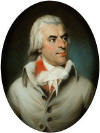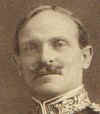
When modern scholars refer to Arthur Young (1741 – 1820) they usually connect the English travel author with the observations he made at the beginning of the French Revolution. But this son of a reverend made travels, and recorded equestrian wisdom, which still affects us today.
As a young lad Arthur was dispatched in 1758 to work as a merchant, but it soon became apparent that he no interest in commerce. After his father's death Arthur’s mother placed him in charge of the family estate. It was this lucky chance that resulted in Arthur becoming one of history’s most renowned experts on agriculture.
Having married in 1765, and then obtained his own large farm, Arthur began a series of journeys which were to have far-reaching consequences.
His first trip took him to Ireland in 1776, where he made detailed observations on agricultural practices. Sadly, Young’s extensive notes of this journey were lost when the trunk carrying his notes was stolen by a disgruntled servant.
Luckily for equestrian history Arthur went on to Wales and the English Midlands without any delay.
In the autumn of 1776 Young composed a note on a new type of equine feeding being done in the English countryside. He wrote, “Carrots are very much cultivated upon the sand, about Bowood, by the Bath gardeners, there being no sand between that place and Bath. They pay 50s. an acre for it, from May-day to Michaelmas; dig it two spits deep, and sow it broadcast; they get from 3 to 3 ½ bushels per pole square: the farmers sow some for horses, and give them washed instead of corn, and find it answers very well. Another article, in which they have also much to commend, is their applying carrots to the food of their horses; this is no great practice yet, but its being known at all is no slight instance of merit.”
Thanks to the book which Young wrote about this trip, Tour of South Wales and South Midlands, the idea of feeding carrots to horses made rapid progress in England. By 1784, when Young made his Tour of Suffolk, the practice of feeding carrots to horses had become widely recognized by astute English farmers.
Young wrote, “To Ipswich, where I catched a hasty walk with Mr. Turner over a part of his farm. I had the pleasure of finding from him that he fed his farm horses last winter with carrots, giving them no corn whatever; and they were in as good health and did their work as well as when supported on corn alone. He kept 18 horses a whole winter on carrots, with the common allowance of chaff and corn, substituting the carrots for hay. When Mr. Gross did use carrots he gave his horses each one bushel a-day with chaff, but no oats; and assured me that he had much rather feed on carrots than on oats; also that they save more than half the hay; he has known his horses, after feeding on this root to refuse their hay entirely. That the horses are never in such condition as on carrots, and will upon such food go through all the work of the season, being the best that can be given to a cart-horse; but will not do for horses that are rode fast.”
Never one to pull his punches in print, Young also made an appeal to England to breed more useful horses, especially the famous Suffolk Punch draft horse, instead of focusing on breeding more Thoroughbreds.
“I leave it to people of reflection to consider whether there would not be more good sense in giving royal rewards to the victors in such matches as these, which encourage a race of horses useful in a superior degree, rather than for running races with a breed that is good for nothing else.”
Arthur Young was the greatest of all English writers on agriculture and his expertise resulted in an invitation being extended to tour France on the eve of the great political rebellion. Accompanied by his beloved mare he crossed the Channel and landed in France in May 1787. Travelling to various parts of that country he unintentionally documented the vast difference between the privileged lives led by the aristocracy and the down-trodden peasants. At one chateau Young noted, “The stable is truly great and exceeds very much indeed anything of the kind I had ever seen. It is 580 feet long and 40 broad, and is sometimes filled with 240 English horses.”
In stark contrast to such equine opulence were the desperate conditions which the common people were forced to endure. Young was greatly moved by this economic disparity. When he returned in November he concluded his journal with the observation that he had “more pleasure in giving my little girl a French doll than in viewing Versailles.”
Despite his reservations about France, he returned there again at a critical juncture in the country’s history. Once again mounted on his faithful mare, Young set off to explore the kingdom on horseback. This time the journey quickly fell to pieces.
A distraught Young wrote, “I found that my mare, from illness, would travel no further; French stables, which are covered dunghills, and the carelessness of garçons d'écuries, an execrable set of vermin, had given her cold.”
Only a hundred miles into what was supposed to be another long trip, the mare fell blind. Despite the difficulties, the loyal Young refused to abandon the animal.
“After riding her three thousand seven hundred miles humanity did not allow me to sell her.”
In October of 1788 the loyal Long Rider managed to bring the horse back to the safety of England.
Having secured the mare’s well-being the ever vigorous Young continued to travel. In 1789 he returned to Paris, via a coach used to carry passengers and the mail. His keen observation that those who travel enclosed confined within a vehicle “learn little and do nothing,” could be seen as a prophetic statement about the limitations of motorized transport.
By the time Young died in 1820 he had travelled in excess of twenty thousand miles. His many books not only contain a wealth of detail about agricultural practices, they also provide a peek into the past. Like today their reveal how little the inhabitants of one nation know about their neighbours.
Young wrote, “I met a well-dressed French merchant who plagued me with an abundance of tiresome and foolish questions. Had we any trees in England? I replied that we had a few. Had we any rivers? Oh, none at all I said. Well that is very sad, the Frenchman replied.”


Younghusband's delightful book, Eighteen Hundred Miles on a Burmese Pony takes the reader on a mounted journey complete with the requisite adventures, but with the added delight of a pint-sized hero you’ll never forget.